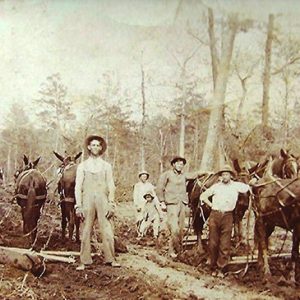calsfoundation@cals.org
Banner (Cleburne County)
Banner is located on Highway 87 (also called Floral Road) less than two miles from the point at which Floral Road joins Highway 25 N (Heber Springs Road) in Concord (Cleburne County). Floral (Independence County) is nearby. Until Cleburne County was formed on February 20, 1883, Banner was in Independence County; the community has close ties with both counties.
A colorful pioneer of Banner was Elijah (Lige) Collard, a Kentuckian who blazed a trail to Healing Springs Township (then in Independence County) between 1845 and 1850. Collard supposedly spent time with Native Americans around the mineral springs in what is today Heber Springs (Cleburne County). One day in the 1850s, he was confronted on his trek to the springs by a hungry bear. The story goes that he killed the bear with his hunting knife and made a coat out of its hide. Later, a picture was taken by a traveling photographer of Collard in his bear-skin coat.
Mount Zion Church was organized by the Missionary Baptists in 1860, although it faced some disruption during the Civil War. The Missionary Baptists received approximately three acres of land from Joel Mark Jeffrey and Candace Elizabeth Martin Jeffrey on May 27, 1876. The cemetery occupies about two thirds of the property; the Mount Zion Church and grounds were on the northern part. The original church fell into disrepair and was burned by vandals in 1983. The foundation is still visible. The new Mount Zion Church is on Highway 87 across from Banner Loop, which leads to the Mount Zion Cemetery (the main cemetery for Banner) and the ruins of the original church.
The Civil War divided the residents of Round Pond, the old name for the area. In the early days of secession, the Reverend James Wimberly Murray, a Methodist Episcopal minister, was shot to death in his front yard at Cedar Grove (Independence County), accused of being an abolitionist. Murray is said to have been the first person buried in the Mount Zion Cemetery.
The origin of the Banner name is unclear. A Bonner family settled in nearby Floral after the Civil War, coming from Iowa via Missouri, and married into families such as the Altons and Altoms, already living in the area. Loren Reed Bonner and one of his sons, Albert Reed Bonner, became postmasters of the Alonzo Post Office in the vicinity of Floral and Banner in the early 1900s. Some believe the name Banner is a misspelling of the name Bonner.
The post office opened on February 14, 1879. Before that, Banner was served by the Concord and Pleasant Plains (Independence County) post offices. Thomas Jackson (Jack) Brown, who lived in Floral, was appointed first postmaster. Brown was born in Brownsville, Tennessee, coming to Round Pond at age four in 1850. He married Lucy Jamani Stuart—also born in Haywood County, Tennessee—in Healing Springs Township in 1868. Both the Brown and the Stuart families became community leaders in the Banner region. Joseph Hampton Collard left Kentucky about the same time as the Stuart and Brown families left Tennessee. NASCAR driver Mark Martin of Batesville (Independence County) is a direct descendant of the Collard and Stuart families of Banner.
The main store in Banner eventually became the Banner General Store, Post Office, and Feed Store, located in the center of town. Doyne Stuart and his brother-in-law Clyde Martin owned and operated the store at one time. Clyde Martin is Mark Martin’s grandfather. In the 1960s, Banner also had a skating rink.
Before consolidation with the Concord school, the children of Banner had at least two options, a school known as Mount Edna (a.k.a. Mount Etna)—not to be confused with the Mount Etna School near Cushman in Independence County—active by 1911, and Starnes Spring School, which was still active in 1936.
By 1931, Banner was home to Dr. William Henry White. White and his wife, Opal Elizabeth Harvey White, moved to Banner from Maynard (Randolph County). White retired from medicine in 1956 and continued to live in Banner for the rest of his life. The Arkansas Department of Transportation began the construction of Highway 87 through Banner around 1945, making it easier to travel to Concord and to Floral. White agreed to let the highway department construct temporary buildings on his land to house the employees working on the new road with the understanding that he would get to keep the buildings once the road was finished. His wife then used the buildings to raise chickens. The chickens were sold to help pay for bringing electricity to Banner. This chicken operation is thought to be the beginning of the lucrative poultry business in the region.
The soil around Banner is not suitable for large cash crops, so patches for truck farming and fruit orchards, especially peaches, are common, as well as livestock raising on a small scale. Broilers became big business in the 1940s and 1950s. One of the leading Arkansas poultry entrepreneurs, J. K. Southerland, came from Banner and opened a feed store in nearby Floral. He later moved the center of his operations to Batesville.
After the closing of the post office in 1971, the main grocery and feed store, owned and operated by the Stuart family, also ceased operations. Metz and Johnny Stuart tried a building supply business later, but to no avail. The building was razed. The Mount Zion church remains active, and a few houses dot the landscape, but no businesses are located in Banner in the twenty-first century.
For additional information:
Berry, Evalena. Time and the River: A History of Cleburne County. Little Rock: Rose Publishing Company, 1982.
Biographical and Historical Memoirs of Northeast Arkansas. Chicago: Goodspeed Publishing Co., 1889.
Kenneth Rorie
Van Buren, Arkansas
 Cleburne County Map
Cleburne County Map  Elijah Collard
Elijah Collard  Independence County Logging
Independence County Logging  Mount Etna School
Mount Etna School  Mount Etna School
Mount Etna School  William Henry White
William Henry White 



Comments
No comments on this entry yet.